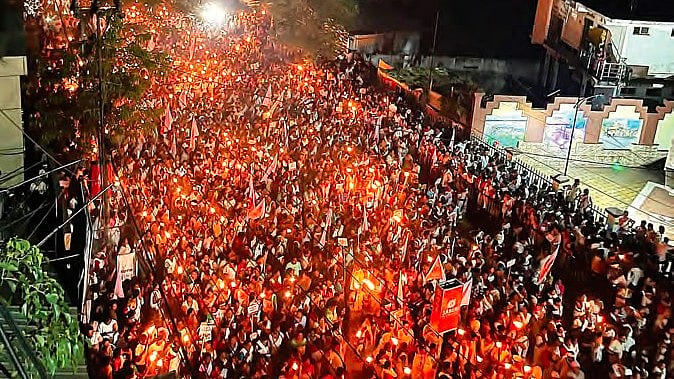POLITICS
Assam: Poll gambit or social time bomb?
The agitation by six communities is a stiff political challenge for the Himanta Biswa Sarma government. Or is it?

The government of Assam seems confident that the controversy surrounding singer Zubeen Garg’s death has largely subsided. While Zubeen’s viscera report was awaited at the time of writing, indications are that it is unlikely to spring any surprises. At a press conference on 6 October, chief minister Himanta Biswa Sarma even encouraged citizens to access a copy of the post-mortem report from the courts.
That done, he moved on to attack Congress leader Gaurav Gogoi. Political observers interpret this return to ‘business as usual’ as a sign that Sarma believes he has successfully convinced the public that the probe into Zubeen’s death was prompt, adequate and credible and — most importantly — is unlikely to hurt the BJP in the Assembly elections due for early 2026.
The fallout of Zubeen’s death or Gaurav Gogoi’s challenge are not the only issues Sarma is navigating in the run-up to the elections. Another issue is rapidly gaining momentum, posing a much larger political and social challenge.
Since early September, six communities of Assam — Moran, Koch-Rajbongshi, Tai Ahom, Matak, Chutia and Adivasi Tea Tribes — have taken to the streets, reiterating their demand for Scheduled Tribe (ST) status. Currently classified as Other Backward Classes (OBCs), these groups are now mobilising in large numbers across the state.
Their demand isn’t new. In fact, before the 2014 elections, the BJP — including Prime Minister Narendra Modi — had publicly promised ST status to these communities. But 11 years and multiple negotiations later, the promise remains unfulfilled.
Spread across Assam, the areas inhabited by these communities are currently administered through autonomous district councils (ADCs). Their demand extends beyond ST recognition — they also seek inclusion under the Sixth Schedule of the Constitution, which would safeguard land rights, cultural identity and socio-economic security through the existing ADCs.
Published: undefined
Currently, Assam has three ADCs with Sixth Schedule status — the Bodoland Territorial Region, the Dima Hasao Autonomous District Council and the Karbi Anglong Autonomous Council.
On 11 September, nearly 20,000 protesters led by the All Moran Students’ Union (AMSU) representing the Moran community organised a torch rally in Tinsukia, breached police barricades and marched through the town’s main street.
On 12 September, the Koch-Rajbongshi community clashed with the police in Golakgunj area in lower Assam, triggering a 12-hour bandh. The Matak community held rallies in Tinsukia and Dibrugarh on 22 and 26 September. As many as 30,000 to 40,000 people joined each of these marches.
Simultaneously, over 10,000 Tai Ahom people rallied in Sadiya. Keeping Assam’s tradition of student protest alive, the latest round of community protests was also spearheaded by students’ unions.
The Assam government has reconstituted a Group of Ministers (GoM) to address the demands, determine the quantum of reservation for the six communities, suggest revised OBC reservations and ensure safeguards for existing STs.
“When we met the chief minister after the rally, he told us he will table a report on 25 November and forward it to the Centre the following day,” said Palindra Borah, AMSU president. “He requested us to give him one last chance and said we could resume our agitation if the Centre did not respond.”
While on the surface the protests appear anti-government, many believe they are being tactically allowed, even encouraged, by the BJP. “The idea is to create a crisis and then resolve it just before elections, thereby allowing the party to claim credit,” says a senior journalist.
Published: undefined
There are also questions about funding, with each rally costing an estimated Rs 8-10 lakh. “Where is the money coming from if local traders in Dibrugarh or Sivasagar are not contributing?” he asks.
Holiram Terang, former MLA, vice-president of the United People’s Front (New) and convenor of the Hills State Demand Council concurs. “The state government is neither actively opposing nor initiating a crackdown on the protests. An agreement closer to the elections will work in favour of the BJP,” he adds.
Assam’s existing tribes are not united in supporting the demand for ST status for new groups. Many fear that this will reduce their existing share of reservation benefits and protections. In fact, Bodo leader Pramod Boro’s recent comment that Koch-Rajbongshis do not need ST status — as they already enjoy OBC status — triggered a protest by the All Koch-Rajbongshi Students’ Union (AKRSU) in Guwahati on 9 September.
Beyond short-term political gain, granting ST status to the six communities will have long-term consequences. The state’s projected population in 2025, based on 2011 census data, is 3.7 crore, with 12.4 per cent currently classified as tribal. With the addition of OBCs, the tribal population could jump to nearly 40 per cent.
This opens the door to Assam being declared a ‘tribal state’, which would necessitate significant changes in land rights, political representation and cultural preservation. Such a shift could alienate Assam’s non-tribal communities and reignite ethnic fault lines that have long simmered beneath the surface.
Tragically, it will also undermine the legacy of Zubeen Garg — a symbol of pan-Assamese unity across caste, tribe and class.
Sourabh Sen is a Kolkata-based independent writer and commentator on politics, human rights and foreign affairs. More of his writing may be read here
Published: undefined
Follow us on: Facebook, Twitter, Google News, Instagram
Join our official telegram channel (@nationalherald) and stay updated with the latest headlines
Published: undefined